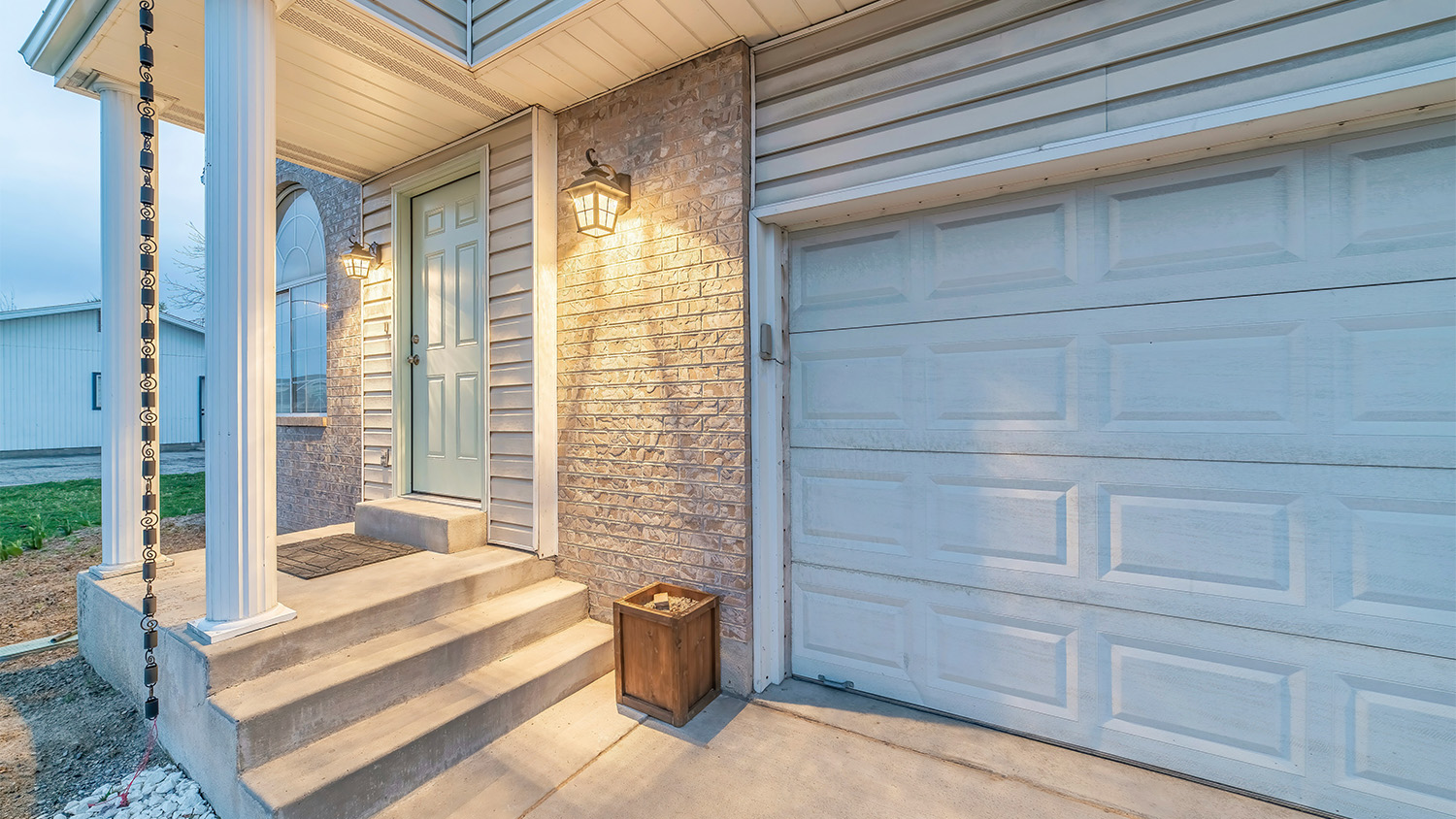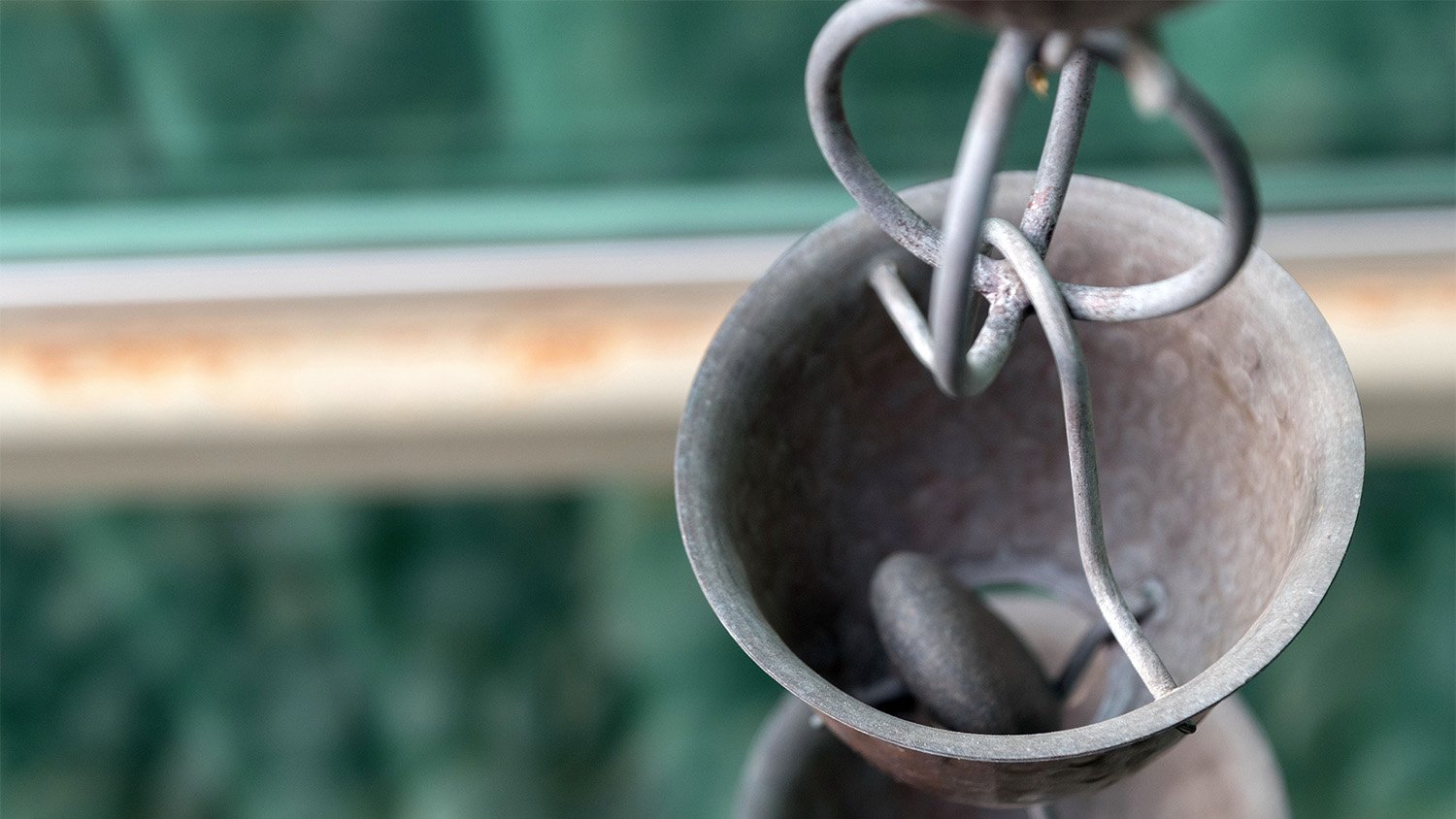
This guide will give you an idea of how much you can expect to pay when getting new seamless gutters installed when accounting for removal, labor, and different gutter materials.
It could be time to say goodbye to those bulky downspouts


Rain chains cost between $50 and $200 apiece on average.
Rain chains are a more aesthetically pleasing alternative to downspouts.
They aren’t the best solution if you live in a region prone to high winds and heavy rainfall.
Cup designs produce less splashback than plain chains.
Gutter systems’ downspouts might serve an essential practical purpose, but, let’s face it, they’re not that easy on the eye. Rain chains are decorative and functional downspout and gutter alternatives that have become trendy over the last decade or so. Learn more about what rain chains are, when you can use them, and how they provide a wow factor to your home’s exterior.
Rain chains (kusari-doi) originated in Japan hundreds of years ago and only recently made their way over to the United States. As the name suggests, a rain chain is a chain that hangs off your gutter where a downspout would otherwise go to collect rainwater.
This rainwater management system usually consists of a series of cups spaced out along the chains for aesthetics and rainwater collecting. The rain chain directs water down the chain and away from your roof, siding, foundation, and landscape.
With a rain chain, you can go ahead and skip the spa on a rainy day. Rain chains are designed to be showcased for their beauty, and they also exude a gentle, peaceful sound as rain flows down them.

Rain chains connect to gutters or eaves in place of the downspout. Normally, the rainwater from the roof flows into an enclosed pipe, but with rain chains, the water visibly follows the chain and sometimes goes through a series of cups or other stylistic elements before flowing down to the ground or, more often, into a barrel or water feature. The cups have holes or funnel-like shapes to help hold extra water and maximize the amount of rainwater that can be collected.
As with a downspout, by following this path, the flow of water slows, minimizing soil loss and erosion on the downpour site, and it keeps the water from running freely down the side of your house.
The cups add an even greater aesthetic while collecting rainwater so that it continues to flow down the chain more slowly.
If you’re looking for an elegant alternative to plain metal or vinyl downspouts, you might want to opt for rain chains. It’s calming to see and hear the water ebbing and flowing down the chain as rain falls. Some people describe them as functional water features.
Collecting the rainwater in a barrel at the bottom of the chain is a great way to conserve water, especially in drought-prone regions. Use it to irrigate your landscape, provide a water source for wildlife, top-up outdoor ponds, or even use rainwater in the home with the proper treatment.
Some rain chain designs are more functional than others. While you’re shopping for the best rain chain for your home, you’re likely to stumble on two main types: cup rain chains and chainlink rain chains.
The most simple style is a length of chain made from metals like brass, copper, steel, or aluminum. This minimalist design creates the most splashback, though, and might not be the best choice for regions that experience heavy rain or for installation next to doors or open windows.
More elaborate designs featuring fluted cups at intervals along the length of the chain are available. While making the chain more costly, these cups better capture and direct the water, meaning splashing is less of a problem. However, they’re heavier than simple rain chains, especially when filled with water, and you’ll need to ensure your guttering can handle this extra weight. Opt for cups that are at least 3 to 4 inches in diameter for them to work effectively.

When you compare rain chains to traditional downspouts, they have some significant advantages. Here are several benefits of choosing rain chains.
They’re easy to install.
Their appearance is aesthetically pleasing.
The sound they produce is relaxing
They can be quieter than your typical downspout.
Rain chains cost between $50 and $200 per chain on average—significantly less than the cost of downspouts.
They’re a good way to collect rainwater.
Rain chains come in many shapes and sizes.
They aren’t limited to just your gutters. You can use rain chains anywhere that supports them, where water flows vertically.
If you choose rain chains over installing gutters, you’ll save on gutter installation costs ranging from $600 to $1,700.
High-quality metal rain chains age well, and copper ones can develop an eye-catching patina.
Sometimes it’s better to stick with downspouts. Despite having much to offer for homes, rain chains come with their fair share of potential downsides worth keeping in mind. Here are some disadvantages of using rain chains:
They’re not as sturdy as downspouts, making them less suitable for use in areas with very high winds and heavy rainfall.
Rain chains have less water capacity and control than downspouts.
Weaker gutter materials can become damaged under the weight of heavy rain chains.
Water freezes quickly on the chains, adding weight to the gutters and eaves.
Bad weather and improper installation can result in improper water direction—and, in the worst-case scenario, you might start seeing signs of foundation damage.
Poor placement can also cause improper water flow, which can damage your landscape or home’s siding.
Splashing from rain chains can send water to places you don’t want it, such as your porch, patio, walkway, driveway, or even on your car.
Not everyone likes the sound of rain chains, which can be distracting for some.
As with cleaning your gutters, rain chains require routine maintenance to remove debris and keep the chains operating at full capacity.
Some metals leach toxic materials, so you won’t want to use any captured rainwater for ponds or birdbaths.
Gutter repairs are a fairly common home maintenance expense. Even though gutters can last 20 years or more with proper care, they often require repairs throughout their lifespan. According to Angi data, 26% of homeowners who request gutter repair report sagging gutters or sections that have broken loose. Additionally, 14% of homeowners say their downspout or gutter is clogged, disconnected, or broken. Rain chains can mitigate issues with clogs since they would replace downspouts.
The best way to use a rain chain is by removing the downspout and securing the rain chain to the opening so that your gutters flow directly to the rain chain. However, it’s important to note that you don’t have to remove all of your downspouts to install rain chains. In fact, it might even be better to have rain chains and downspouts installed in tandem with your gutter system. This is because rain chains aren’t as good at controlling heavy rainfall as downspouts.
For homeowners looking to hide unsightly downspouts without scrapping them entirely, a good alternative is to remove only a few downspouts and replace them with rain chains. That way, you can hide some of the downspouts in the far back or side of your home while making use of those enchanting rain chains in the front or on your patio.
Deciding on whether rain chains are right for your home can be a tough call, but there are a few factors that can play a role in the final verdict.
Firstly, chain chains aren’t usually the best option if high winds and heavy rains are common in your region; they just don’t direct the high flow of water as well as downspouts, and they aren’t as stable either. If you decide to use them for aesthetic reasons, you might want to use them alongside traditional downspouts. Selecting chains made from heavier materials helps, too, as does securing the chain on the ground to prevent the wind from moving it too much.
Secondly, downspouts are a better option for homeowners with narrow eaves less than 3 feet wide unless you use a bracket to extend the chain away from your home.
However, if you don’t have a gutter system and don’t want to invest in a gutter installation, then rain chains offer a relatively inexpensive way to curb excessive rainfall from reaching your home. They’re also portable and easy to take with you if you’re a renter and end up moving.
If you’re still unsure if rain chains are right for your home, your best bet is to reach out to a gutter installer near you for recommendations. Even if you decide to go with rain chains, your pro can help you determine how many you need, where you should install them, what size cups you’ll need, how to efficiently collect rainwater with them, and which rain chain type is best for the job.
From average costs to expert advice, get all the answers you need to get your job done.

This guide will give you an idea of how much you can expect to pay when getting new seamless gutters installed when accounting for removal, labor, and different gutter materials.

Installing copper gutters adds beauty and value to your home. The cost of your project will depend on the size of your home, the size of your gutters, and the thickness of the material.

Here's everything you ever wanted to know about saving money by installing faux copper gutters instead of real copper gutters.

Before investing in a gutter protection system for your home, review micro mesh gutter guard pros and cons to ensure they meet your home’s needs.

Common metal roof gutter problems include clogged gutters, incorrect slopes, gutter leaks, and damage. Keep reading to learn what gutter problems can occur.

Underground downspouts drain water away from your home, but can become clogged. Learn how to locate underground downspouts in this guide.